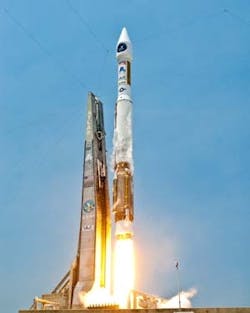Space based infrared missile warning satellite launched by U.S. Air Force
Posted by John McHaleCAPE CANAVERAL AIR FORCE STATION, Fla., 9 May 2011. U.S. Air Force officials launched the first Space Based Infrared System (SBIRS) geosynchronous (GEO-1) spacecraft from Cape Canaveral Air Force Station, Fla., aboard a United Launch Alliance Atlas V rocket. The SBIRS GEO-1 -- built by Lockheed Martin -- will deliver improved missile warning capabilities for the nation while simultaneously improving the nation's missile defense, technical intelligence, and battlespace awareness mission areas.SBIRS GEO-1 includes highly sophisticated scanning and staring sensors that will deliver improved infrared sensitivity and a reduction in area revisit times over the current constellation. The scanning sensor will provide a wide area surveillance of missile launches and natural phenomena across the earth, while the staring sensor will be used to observe smaller areas of interest with superior sensitivity. These dual independent sensors will enhance early warning of missile launches around the globe, support the nation's ballistic missile defense system, greatly expand our technical intelligence gathering capability, and bolster situational awareness for warfighters on the battlefield."Today's successful launch is a tribute to the hard work, dedication, and unmatched expertise of the entire government and industry SBIRS team. I am proud of the women and men who have worked on this spacecraft, and am confident the nation will be proud of its performance on orbit," says Brig. Gen. (select) Roger W. Teague, the U.S. Air Force's Infrared Space Systems Directorate director. "SBIRS GEO-1 represents the dawn of a new era in overhead persistent infrared surveillance that will greatly improve our national security for years to come."The SBIRS team is led by the Infrared Space Systems Directorate at the U.S. Air Force Space and Missile Systems Center. Lockheed Martin is the SBIRS prime contractor, with Northrop Grumman as the payload integrator. Air Force Space Command operates the SBIRS system.Lockheed Martin's original SBIRS contract includes HEO payloads, two geosynchronous orbit (GEO) satellites, as well as ground-based assets to receive and process the infrared data. The team is also under a follow-on production contract to deliver additional HEO payloads and the third and fourth GEO satellites, and associated ground modifications.
